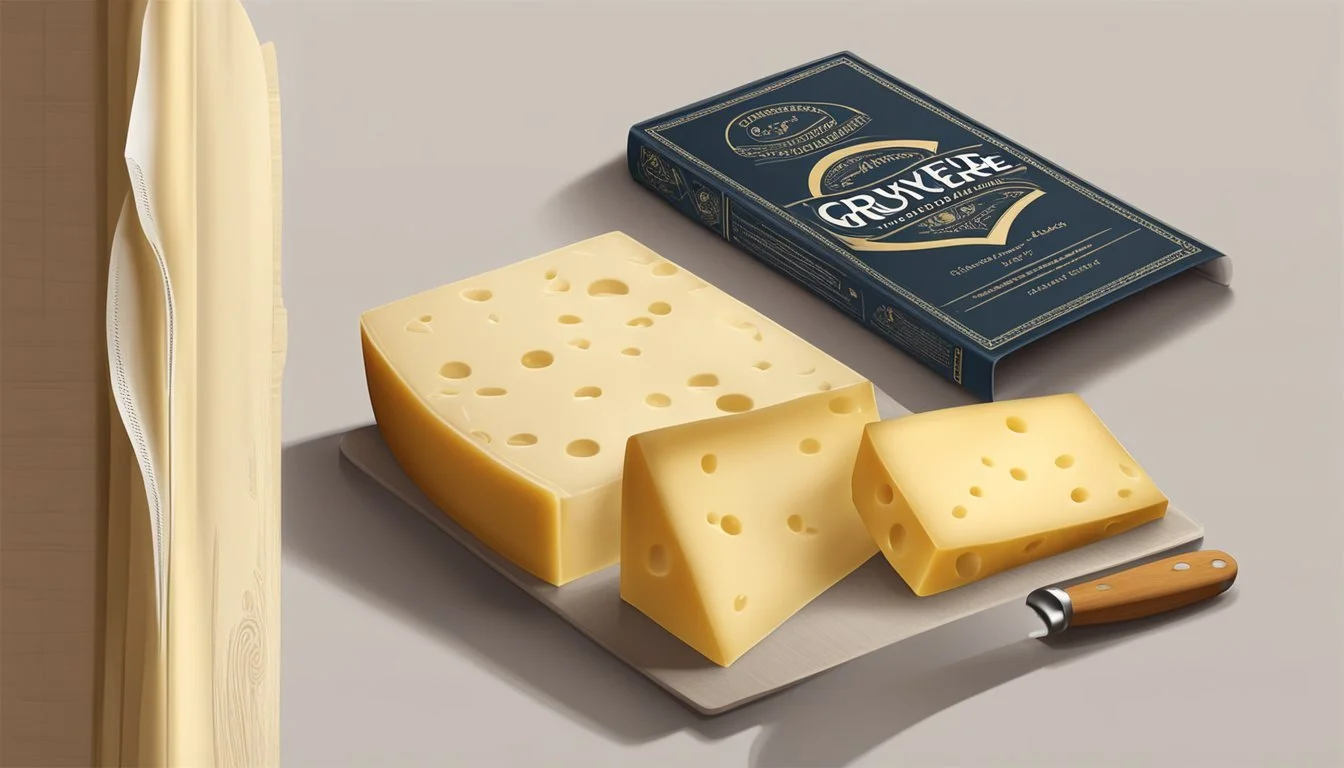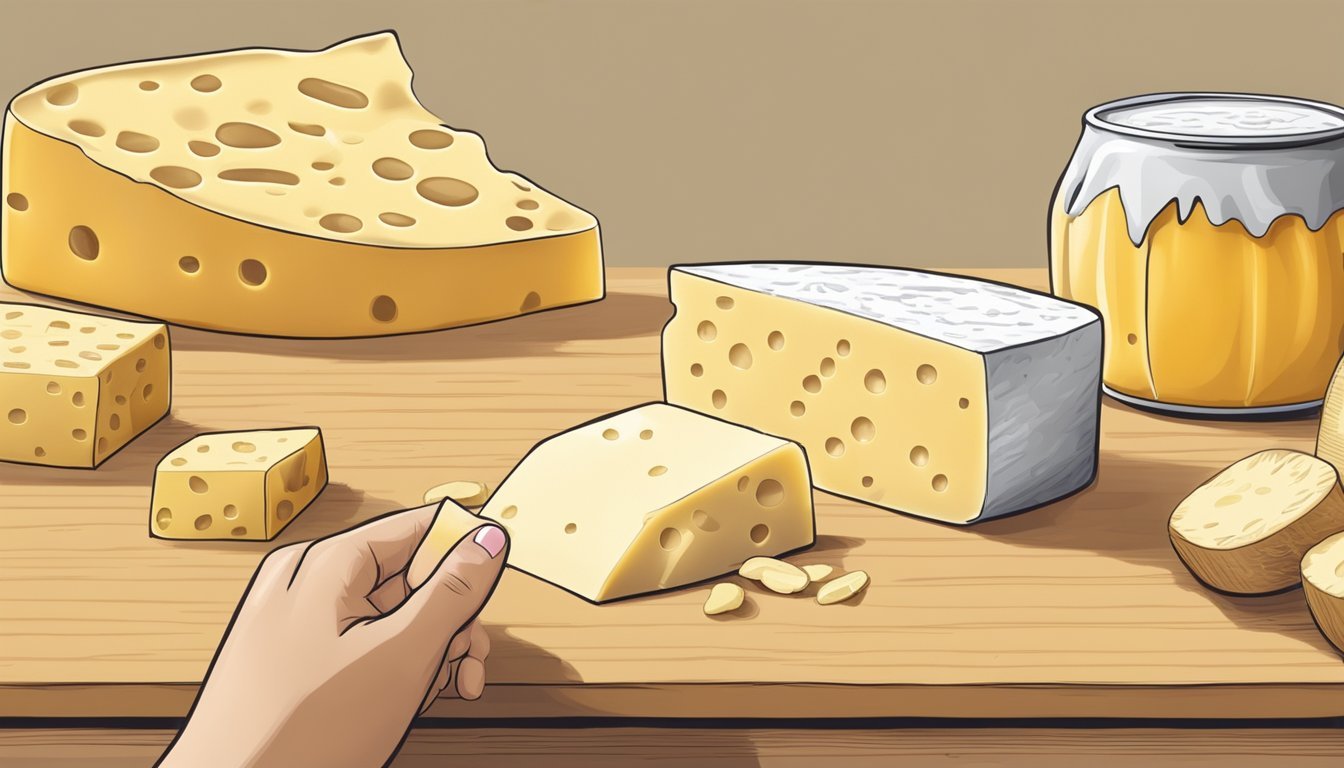How to Substitute Gruyere for Emmental Cheese
Seamless Cheese Swaps in Cooking
When preparing a dish that calls for Emmental cheese (how long does cheese last?), Gruyère cheese (What wine goes well with cheese?) stands out as a prime candidate for substitution due to its similar origins and characteristics. Both Gruyère and Emmental are classic Swiss cheeses with distinctions that lie in their flavor profiles and textural nuances. While Emmental cheese is noted for its mild taste and the signature large holes that typify Swiss cheese, Gruyère presents a more complex flavor with nutty, earthy notes and a slight fruity finish. These attributes make Gruyère an exquisite alternative that can adapt to recipes requiring the smooth melting qualities and rich taste of Emmental.
Gruyère cheese's versatility in the kitchen is widely recognized, with its seamless melting ability making it an excellent choice for a variety of warm dishes, including melt-in-your-mouth fondues, gratins, and savory quiches. (What wine goes well with quiche?) Its rich taste adds depth to the recipes, complementing and, in some cases, enhancing the overall flavor profile of the dish. Although slight differences in taste between the two cheeses may be discernable to a refined palate, Gruyère's adaptability ensures that the end result remains delicious and true to the spirit of the original recipe.
In selecting Gruyère as a substitute for Emmental, one can be confident in its ability to perform well across a multitude of culinary applications, from simple sandwiches to elaborate baked creations. For those looking to capture the essence of Emmental's characteristics in their cooking, Gruyère provides a readily accessible and reliable alternative without compromising on taste or quality. Its widespread availability in food stores makes it a convenient choice for cooks seeking to recreate the creamy and fulfilling experience that Emmental cheese offers.
Understanding Cheese Characteristics
To effectively substitute Gruyere for Emmental cheese, it is essential to understand the nuances of each cheese, from their origins to their flavor profiles and uses in cooking.
Defining Gruyere and Emmental Cheeses
Gruyere cheese and Emmental cheese are both traditional Swiss cheeses with distinctive characteristics. Gruyere, a staple in French and Swiss cuisine, is known for its rich and creamy texture, while Emmental is noted for its iconic holes and a semi-hard texture that's slightly softer than Gruyere.
Texture and Flavor Profiles
Gruyere exhibits a creamy texture that becomes more earthy and complex as it ages. The flavor is rich, nutty, and slightly sweet. Emmental, on the other hand, has a firmer yet still pliable texture with a milder and buttery taste, often described as fruity and nutty.
Nutritional Aspects and Varieties
Both Gruyere and Emmental are high in protein and calcium. There are various age profiles for these cheeses, ranging from young and mild to more mature and pronounced flavors. Emmental typically has fewer varieties compared to Gruyere, which can include variations like Gruyère Alpage, produced from mountain pasture milk.
Culinary Applications
Gruyere and Emmental are versatile in the kitchen. They are staples in fondues, casseroles (What wine goes well with casseroles?), grilled cheese sandwiches, and French onion soup. Gruyere's melting qualities also make it ideal for toppings in pizza and croque monsieur.
Cultural and Geographical Origins
Gruyere hails from the medieval town of Gruyères in Switzerland, and Emmental originates from the Emme valley. These regions have a storied history of cheese production that significantly impacts their characteristic flavors and textures.
Cheese Production and Aging Process
The production process involves traditional methods of curdling, pressing, and aging. Gruyere is aged for at least six months, which contributes to its depth of flavor. Emmental cheese often ages for a slightly shorter period, resulting in its milder profile.
Comparative Cheese Pricing
Gruyere generally comes with a higher price tag due to its longer aging process and the complexity of its flavors. Emmental, being more commonly produced and requiring less aging, is typically more affordable.
Availability and Seasonality
Both cheeses are widely available in grocery stores. Gruyere and Emmental can be found year-round, with certain aged varieties possibly being more seasonal due to the traditional production process in alignment with alpine pasturing seasons.
Cheese Substitutions and Equivalents
If substituting Gruyere for Emmental, one may also consider Comté, Jarlsberg, or Fontina as these share similar melting properties and nutty flavors. The goal is to match the texture and the capacity to blend well with other recipe ingredients.
Allergy Considerations and Non-Dairy Alternatives
Lactose intolerance can render both cheeses unsuitable for some. Non-dairy alternatives like vegan Gruyere and Emmental-flavored soy or nut-based cheeses can be considered, though they may not melt or taste exactly like their dairy counterparts.
Selecting the Right Substitute
When replacing Emmental with Gruyère in recipes, it's crucial to consider factors such as flavor and melting characteristics to ensure culinary success.
Factors to Consider When Substituting
Taste: Gruyère offers a slightly more complex flavor compared to Emmental, often described as rich, salty, and with nutty and earthy notes. Its strong taste should be accounted for, as it can slightly alter the intended flavor profile of a dish.
Texture: Both cheeses are known for their smooth melting qualities, making Gruyère a good substitute for Emmental. Gruyère, however, may result in a somewhat creamier texture.
Holes: While the presence of holes in Emmental is iconic, this is mostly an aesthetic difference and does not significantly impact the cheese's performance in recipes. Gruyère has fewer holes but this distinction is often negligible in cooked dishes.
Suitable Alternatives for Emmental Cheese
When Gruyère is not available or desired, other cheeses can stand in for Emmental:
Jarlsberg: Known for its mild, nutty flavor and similar holey appearance, Jarlsberg can mimic Emmental's characteristics in dishes.
Fontina: This Italian cheese melts beautifully and offers a gentle, slightly sweet taste.
Comté: A French cheese with a complex flavor profile, akin to a stronger version of Emmental.
Appenzeller: Another Swiss cheese with a distinct taste, it can add a different dimension to recipes calling for Emmental.
Note: Softer cheeses like Havarti can be used in sandwiches but might not hold up as well in recipes that require firm structure.
Substituting in Specific Dishes
The type of dish can dictate the best substitute for Emmental:
Grilled Cheese/Pizza: Use Gruyère, Fontina, or a blend of Mozzarella and Cheddar for a good melt and flavor.
Casseroles/Gratins: Gruyère or Comté will provide the desired creamy texture and savory taste.
Sauces/Pasta: Gruyère or Parmesan can offer the necessary consistency and a flavor boost.
Soups/Quiches: Substitute Gruyère or Edam to maintain a similar taste and meltability.
French Onion Soup/Mac and Cheese: Gruyère is traditionally used in French Onion Soup and works well in Mac and Cheese for a sharper taste and smooth melt.
Adjusting Recipes for Cheese Substitutes
When substituting Emmental for Gruyère in recipes, understanding how the flavors, textures, melting qualities, and quantities affect the final dish is crucial to achieve a desired outcome.
Taste Adjustments
Emmental cheese, with its distinctive nutty flavor, offers a slightly different taste profile compared to the slightly sweet and earthy nature of Gruyère. To compensate, one may consider blending Emmental with a small amount of a sharper cheese like Parmesan to mimic Gruyère's depth when used in recipes such as grilled cheese sandwiches or casseroles.
Texture Modifications
Gruyère cheese is known for its creamy texture, which can be either semi-hard or semi-soft. Emmental, while also semi-hard, tends to be a bit firmer. In dishes where cheese is not melted, one might shred the cheese finer to integrate better into dishes, maintaining a creamy consistency without noticeable textural differences.
Melting Behavior
Both Emmental and Gruyère melt well, making them suitable for recipes that require a smooth, creamy melted cheese such as fondue or macaroni and cheese. However, due to Emmental's slightly firmer texture, it may melt at a mildly slower rate. It is advised to grate the cheese when using it to melt, as this will allow for a more uniform behavior in the cooking process.
Quantities and Ratios
When substituting cheeses, it is typically done on a one-to-one basis by volume or weight. Since Emmental and Gruyère share similar properties, a direct substitution in recipes often does not require measurement adjustments. However, one should always taste and adjust accordingly, as the intensity of flavor can vary between different brands and ages of cheese.
Pairing Recommendations
When substituting Gruyere for Emmental cheese, it's important to consider how its rich, creamy flavor and perfect melting quality can complement a variety of pairings.
Accompaniments for Cheese Platters
For a cheese platter, one should select accompaniments that enhance the savory profile of Gruyere. It pairs well with:
Fruits: Sliced apples, pears, and grapes provide a refreshing contrast.
Nuts: Almonds and walnuts offer a crunchy texture and nutty flavor that complements the cheese's own nutty undertones.
Breads: A crusty baguette or hearty rye bread serves as a sturdy and flavorful base.
Vegetables: Pickled vegetables (What wine goes well with pickled vegetables?) or crisp vegetable sticks can add a tangy or fresh dimension to the cheese experience.
Wine and Beverage Pairings
The richness of Gruyere necessitates thoughtful beverage pairings:
White Wine: A crisp Chardonnay or fruity Riesling balances Gruyere's depth.
Red Wine: A light Pinot Noir can complement without overwhelming the cheese.
Non-Alcoholic: Sparkling apple cider provides a sweet and effervescent option.
Food and Cheese Combinations
Gruyere's versatility makes it an excellent substitute in various food pairings:
Cheese Board: Incorporate Gruyere with other cheeses like sharp cheddar or tangy blue for variety.
Meats: Thinly sliced ham or turkey can underscore the cheese's richness.
Cooked Dishes: Melted into a chicken cordon bleu (What wine goes well with chicken cordon bleu?) or over a ham and cheese quiche, Gruyere adds a sumptuous layer.





